The Bambu Lab H2D and H2D Laser Combo brings a refreshing approach to desktop fabrication by offering more than just advanced 3D printing. This next-generation machine delivers an expanded toolkit for makers, integrating laser engraving, cutting, and even pen plotting into a single, cohesive platform. It’s a device that caters to both precision-driven professionals and hobbyists looking to explore new creative territories.
Rather than simply upgrading its core 3D printing technology, Bambu Lab has built a comprehensive system that broadens the entire making experience. With dual extrusion as its foundation and additional modular tools enhancing its capabilities, the H2D and Laser Combo opens up new methods of working with materials. From the design table to the final output, users are given an environment that balances power with ease of use.
What makes this release stand out isn’t just the sum of its features, but how seamlessly they work together. Whether you’re switching between filaments, applying finishing touches with a laser, or slicing materials for overlays and decorations, the transition feels fluid. It’s not a printer that dabbles in other functions—it’s a multi-functional tool that treats each function with equal importance.
Today we are looking at both the Bambu Lab H2D AMS Combo and H2D Laser Combo.
Design and Functionality
The Bambu Lab H2D and Laser Combo presents a sleek, industrial design that hides a complex and capable machine beneath its minimalist shell. The fully enclosed build chamber not only enhances safety but also contributes to consistent print results, especially when working with temperature-sensitive materials.
Its construction feels deliberate, with thoughtful placement of components and easy access for maintenance and tool changes. A set of cameras strategically positioned inside the chamber provides visibility of the entire work area, adding layers of automation and user feedback throughout every job.
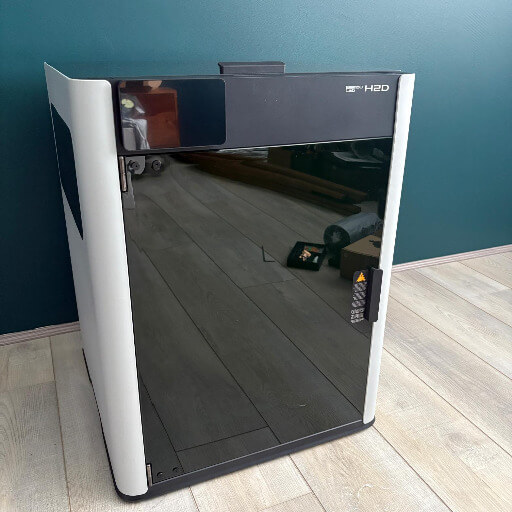
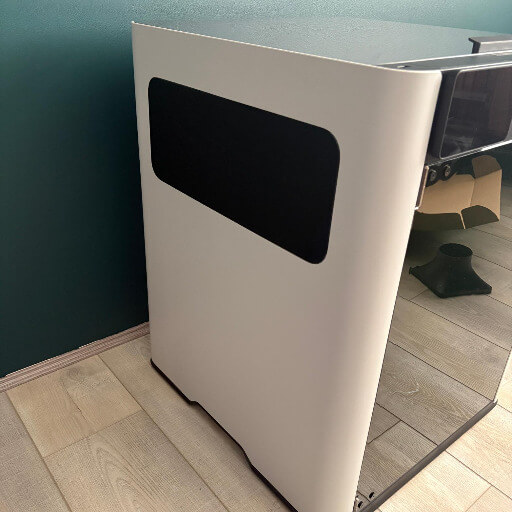
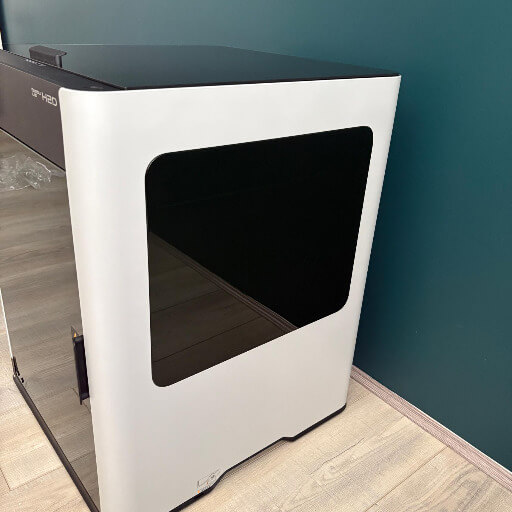
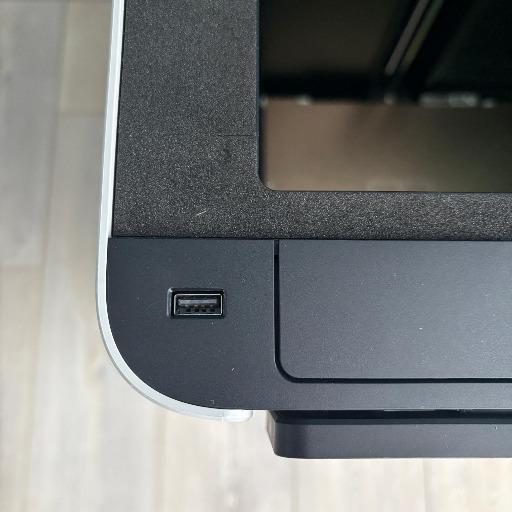
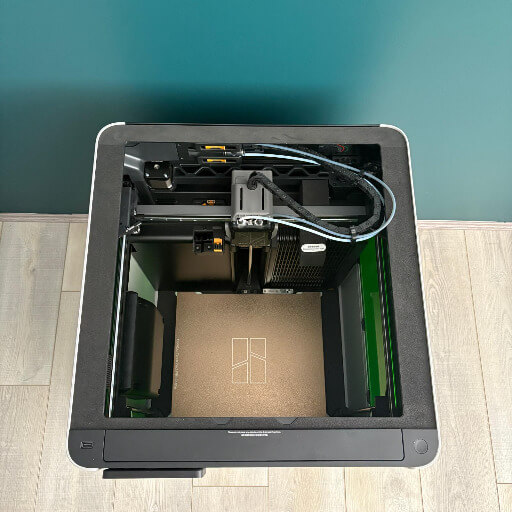
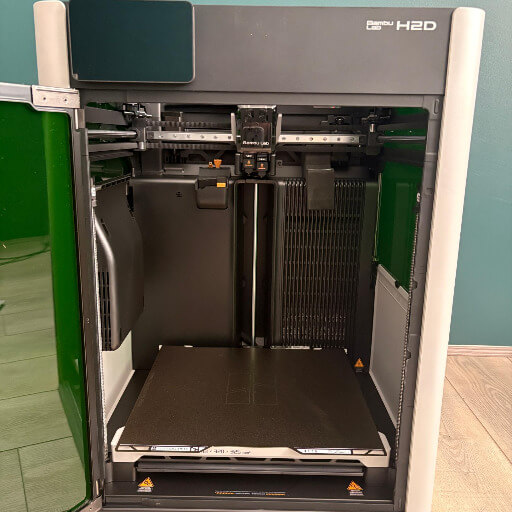
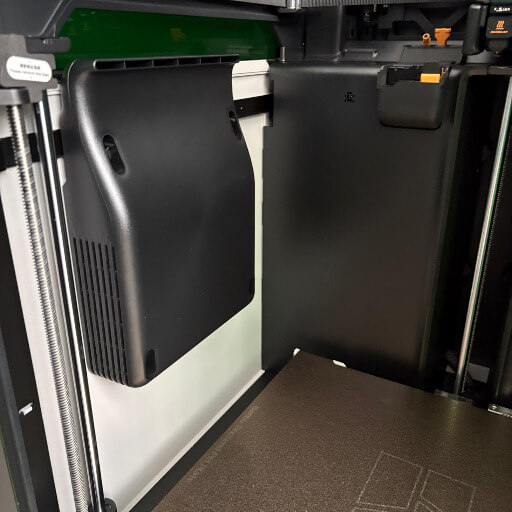
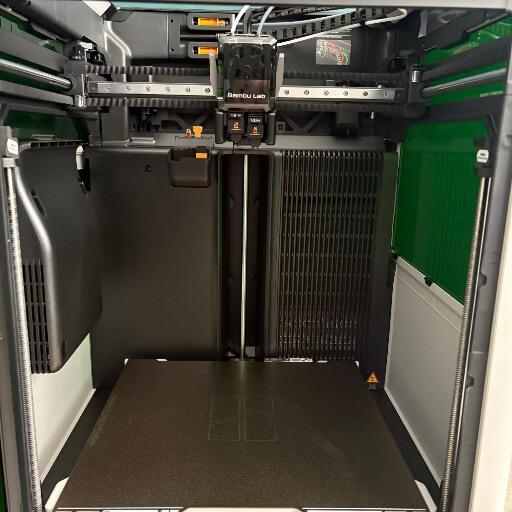
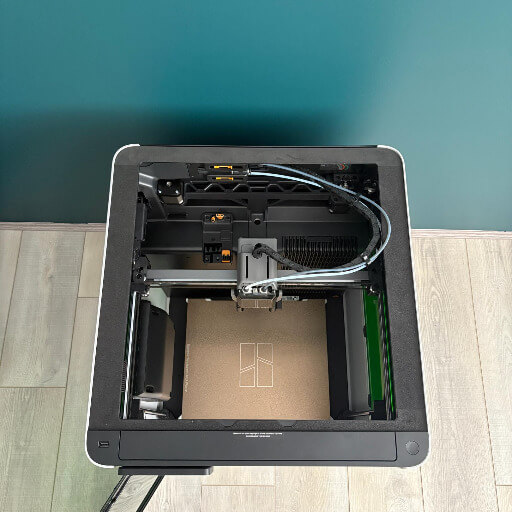
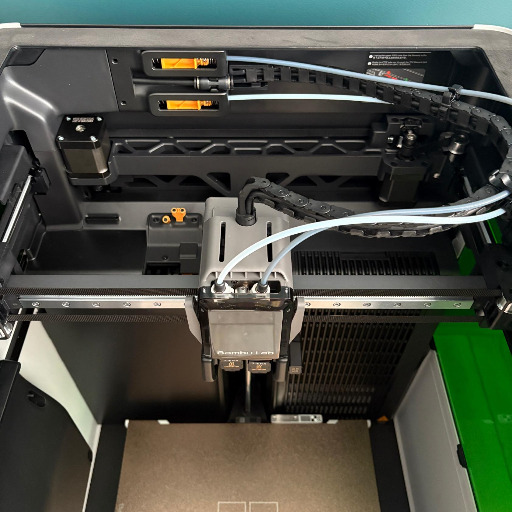
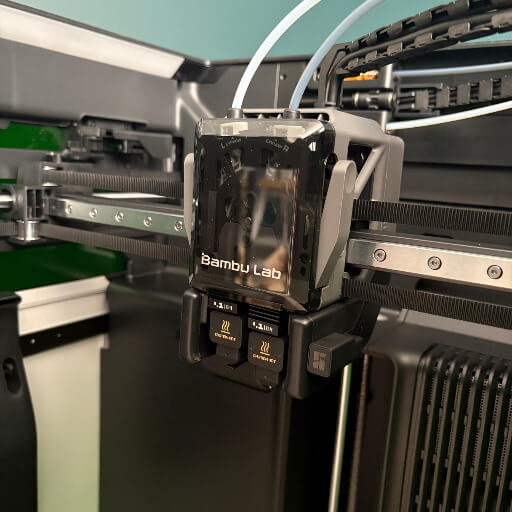
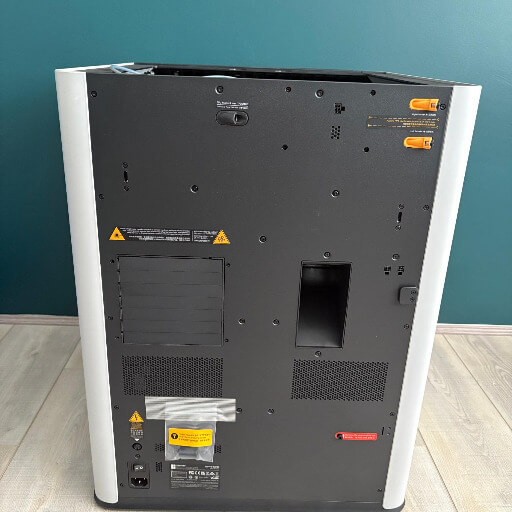
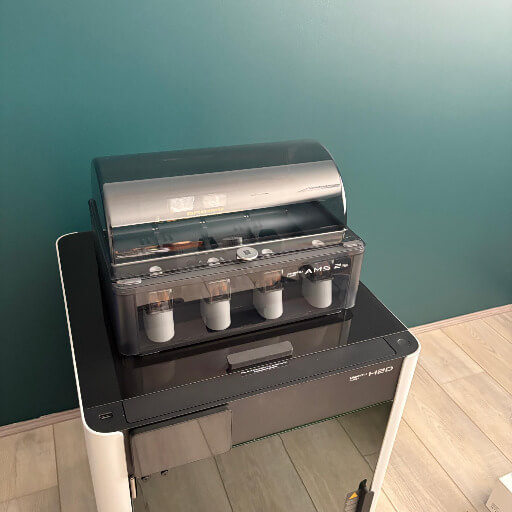
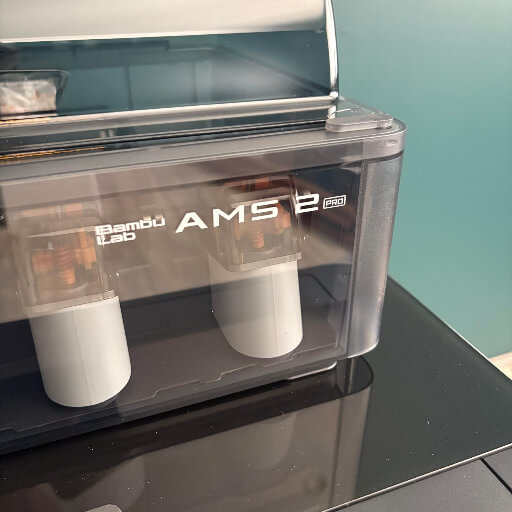

The dual-extrusion print head is mounted on a robust linear rail system, chosen over carbon fibre rods for greater torsional stability. This change brings a noticeable improvement in movement precision, especially during fast travel or sharp directional changes in high-speed prints.
Each extrusion module can be quickly removed and swapped without tools, allowing for seamless transitions between different nozzle sizes or materials. The locking mechanism is intuitive, contributing to the machine’s reputation for reducing downtime and encouraging experimentation.
Bambu Lab has incorporated a smart venting system that adjusts airflow dynamically depending on the task. Whether it’s cooling the chamber for low-temp filament or evacuating smoke during laser operation, the system adapts automatically without requiring user intervention.
An actively heated chamber brings additional flexibility, capable of reaching up to 65°C when printing engineering-grade filaments. For low-temp jobs, air intake flaps open to maintain optimal conditions, demonstrating an intelligent balance between automation and user control.
The print bed heats up swiftly and uniformly, supporting reliable first layers across the generous 350 x 320 mm surface. Print volume varies slightly depending on the configuration, with single-nozzle use allowing for slightly larger builds than dual-nozzle setups.
A dedicated space at the rear of the printer houses permanent filament buffers and a port for flexible filament input. These design elements improve material handling and support the variety of feeding options required by the multiple AMS systems and external spools.
The H2D and Laser Combo’s modularity is its true strength, as additional tools such as the cutting knife, pen holder, and laser modules integrate cleanly onto the print head. Each attaches using a friction-based lever lock, eliminating the need for disassembly and keeping the core printhead permanently in place.
A modern touchscreen interface ties everything together, delivering real-time feedback, progress tracking, and even light-hearted animations. Combined with intuitive software design, it ensures that even complex projects remain accessible from the very first use.
Key Features
At the heart of the Bambu Lab H2D and Laser Combo is its dual-extrusion printhead, enabling the simultaneous use of two hot ends for enhanced multi-material and multicolour printing. This system provides greater versatility and reduces waste by isolating purge-heavy or support filaments to a dedicated nozzle.
Each hot end is independently heated and easily removable, allowing quick swaps for different nozzle sizes or material types. This encourages creative strategies like pairing a small-diameter nozzle for fine detail with a larger one for fast infill, without any need to recalibrate.
A unique actuator system handles nozzle switching within the shared printhead, aligning filament paths, repositioning the active nozzle, and engaging a blocker to prevent oozing. This tri-function design improves print cleanliness and reduces the risk of cross-contamination between materials.
Bambu Lab’s AMS 2 Pro and AMS HT systems integrate flawlessly, offering users sophisticated material management. These systems keep filaments organised, dry, and ready, especially important for engineering-grade or moisture-sensitive materials.
The inclusion of the DynaSense extruder brings intelligent feedback and control to filament flow. It’s powered by a proprietary servo motor capable of monitoring torque, speed, and position, which enhances consistency and precision across various print scenarios.
To accommodate its broad functionality, the H2D and Laser Combo employs multiple onboard cameras for visual tracking, job monitoring, and calibration. A nozzle camera assists in aligning layers and monitoring prints, while others support the automatic placement of laser and cutting designs.
Motion accuracy is improved through an optional calibration plate, used in conjunction with the internal cameras. This helps eliminate dimensional deviations by feeding precise movement data back into the printer’s algorithms.
Tool modularity is a standout feature, with additional modules for laser cutting, engraving, and pen plotting attaching directly to the printhead. This allows the core 3D printing functionality to remain untouched, even when switching to different modes of operation.
The intelligent exhaust and ventilation system reacts to different jobs, filtering fumes and venting smoke automatically. Optional accessories can be added to scrub air before releasing it, making the machine suitable for indoor environments with limited airflow.
User safety is reinforced with built-in fire sensors, a sealed chamber, and a prominent emergency stop button included with the full Laser Combo. These features contribute to a machine that balances advanced capabilities with peace of mind.
3D Printing Functionality


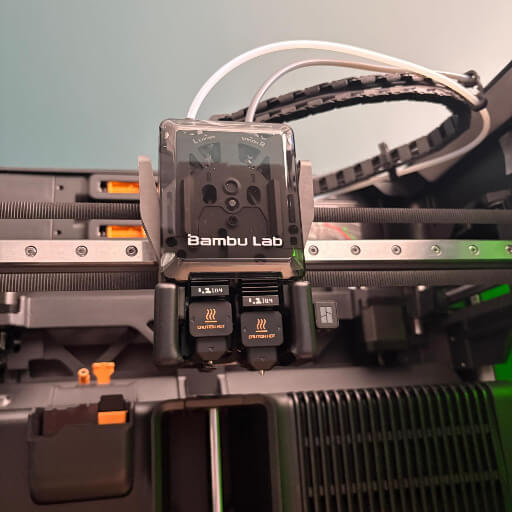
The Bambu Lab H2D and Laser Combo offers a robust 3D printing platform with a 350 x 320 x 325 mm build volume, though usable dimensions adjust slightly depending on whether one or two nozzles are active. This makes it ideal for medium-format prints without requiring the space of a full industrial unit.
Print speed is a key strength, with the machine capable of hitting up to 1,000 mm/s and accelerating at 20,000 mm/s². These impressive figures translate into quicker jobs, particularly for larger models, while retaining strong print stability and detail.
Dual extrusion opens the door to more efficient multicolour and multi-material printing. The system enables you to assign different filaments to specific nozzles, such as reserving one for dissolvable supports or colour-heavy parts, helping reduce purging waste.
Material management is streamlined thanks to the AMS 2 Pro and AMS HT units, which dry, sort, and load filaments with minimal intervention. These modules integrate with the printer and slicer software to optimise material use and maintain filament quality over long print jobs.
Bambu Lab’s slicer includes a filament grouping wizard, which automatically suggests nozzle assignments for your selected materials. This small feature significantly reduces waste, improves efficiency, and simplifies decision-making during setup.
For users who change filaments frequently, the convenience mode intelligently matches filaments to the most practical nozzle. It also tracks usage history to suggest optimal configurations for recurring projects.
The printer supports high-flow hot ends, achieving a material throughput of up to 40 mm³ per second under ideal conditions. This ensures that the machine can keep pace with demanding prints while preserving layer fidelity and surface finish.
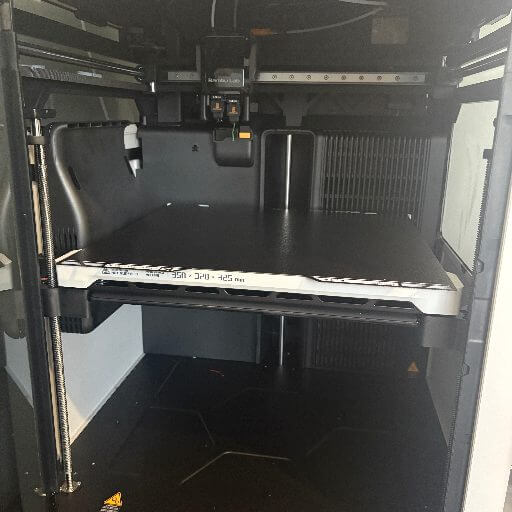
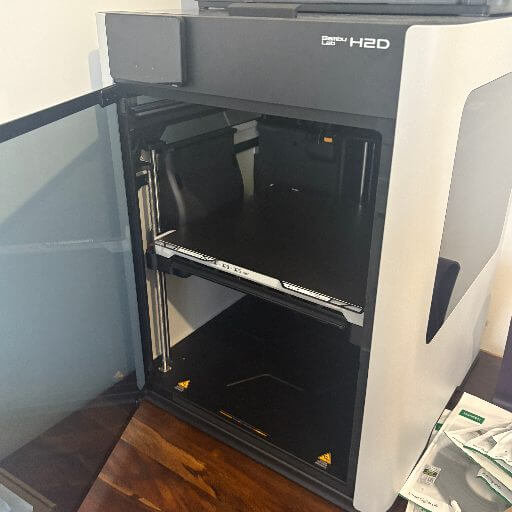
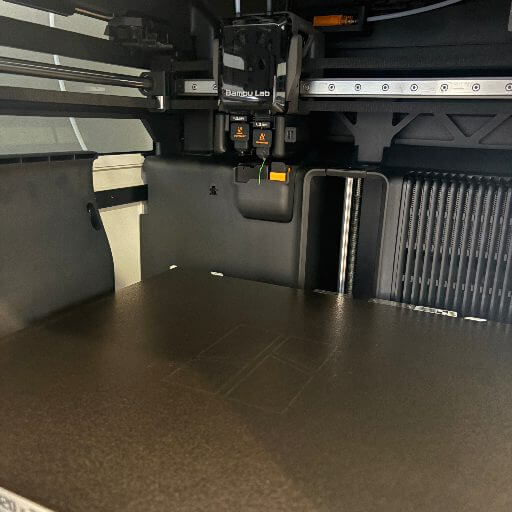
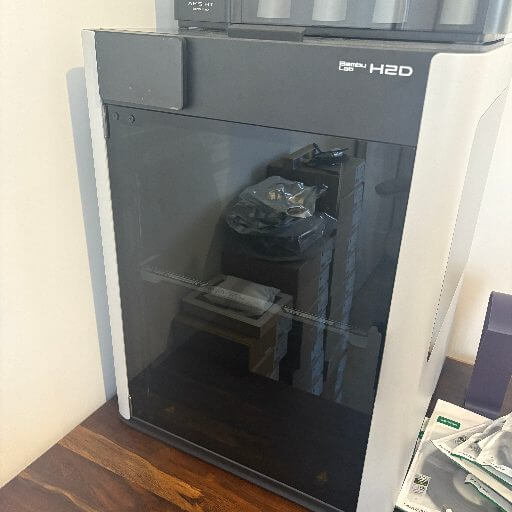
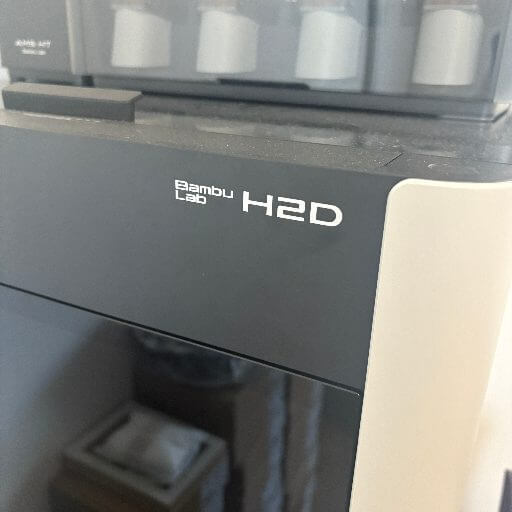
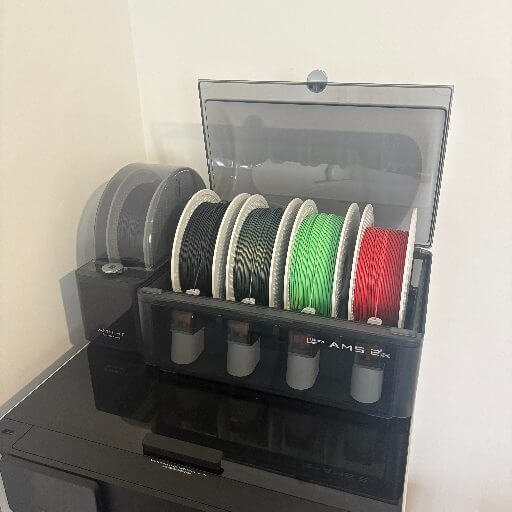
Flexibles are also supported, though they must be loaded manually via a dedicated input port at the rear. This approach requires a little more setup, especially when using filament dryers or AMS units in tandem, but it delivers reliable results once configured.
Layer uniformity from the H2D and Laser Combo is among the best seen in desktop machines, thanks to its motion control system and DynaSense extruder. Smooth and consistent layering enhances not just aesthetics but also the mechanical strength of parts.
Bambu Studio, the companion software, offers a more visual and user-friendly experience than ever before. Model previews, AMS synchronisation, and plate selection are all intuitive, helping users of all skill levels set up print jobs with confidence.
Laser Functionality
The Bambu Lab H2D and Laser Combo introduces laser functionality with a modular approach, offering both 10W and 40W diode laser modules depending on the user’s needs. These modules easily attach to the main printhead, allowing quick conversion between 3D printing and laser tasks without removing the base toolhead.
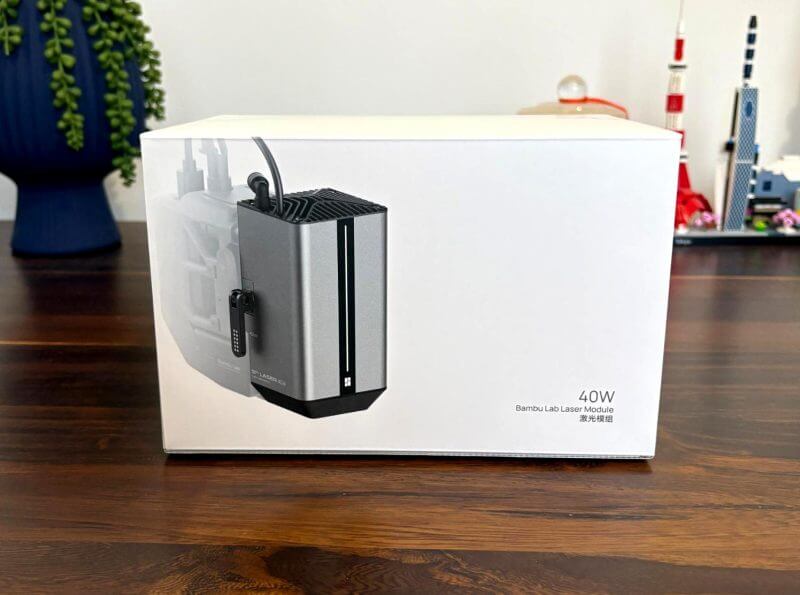
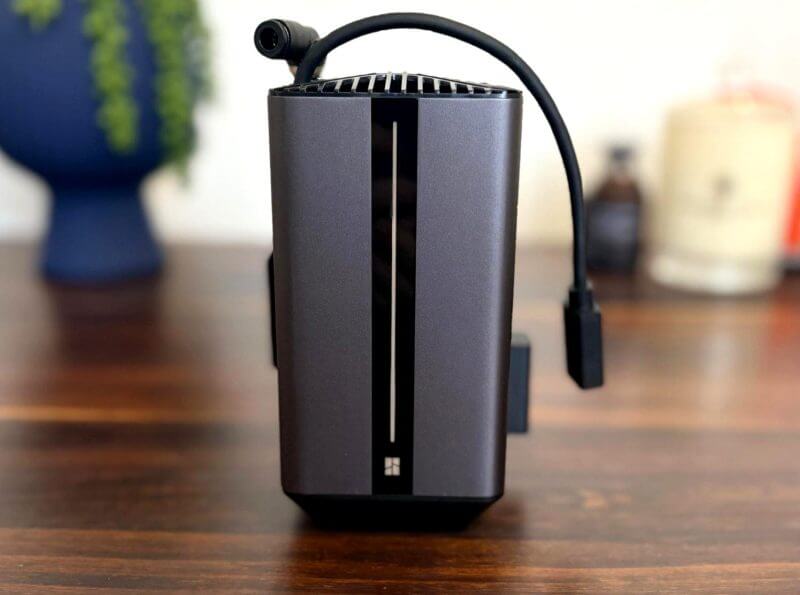
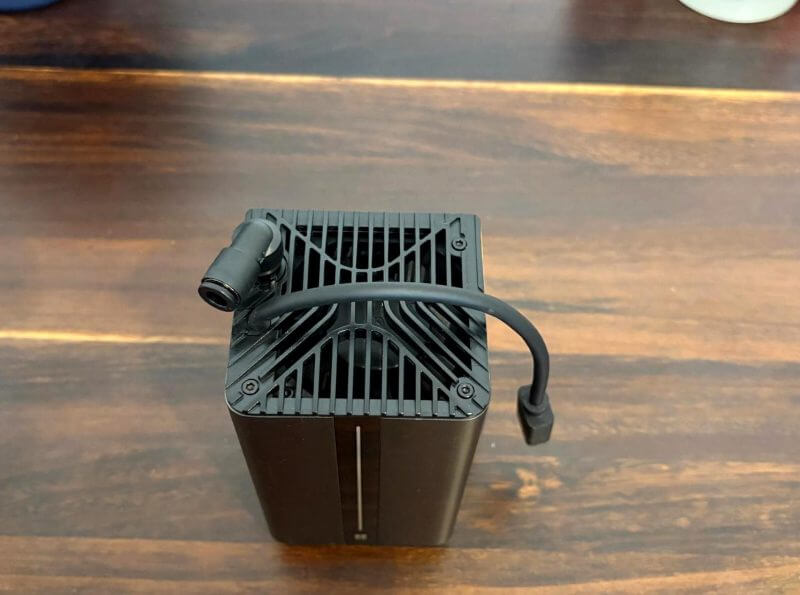
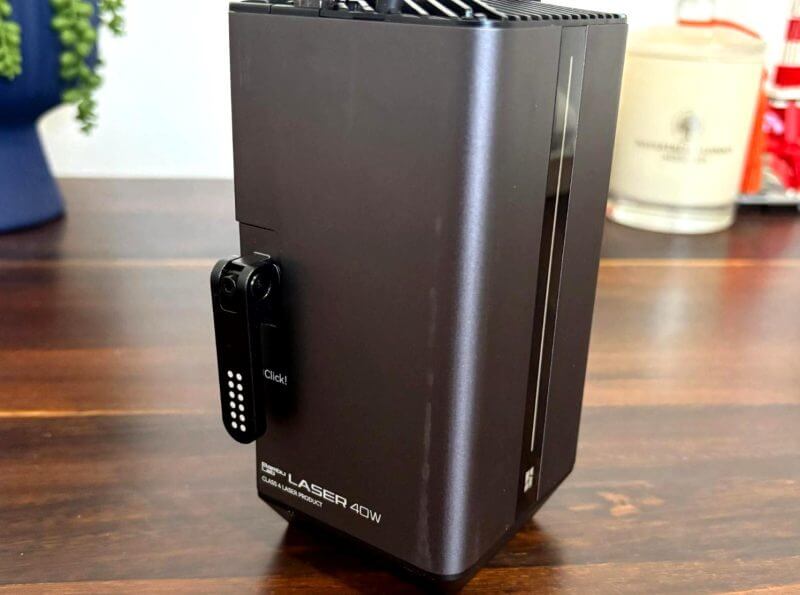
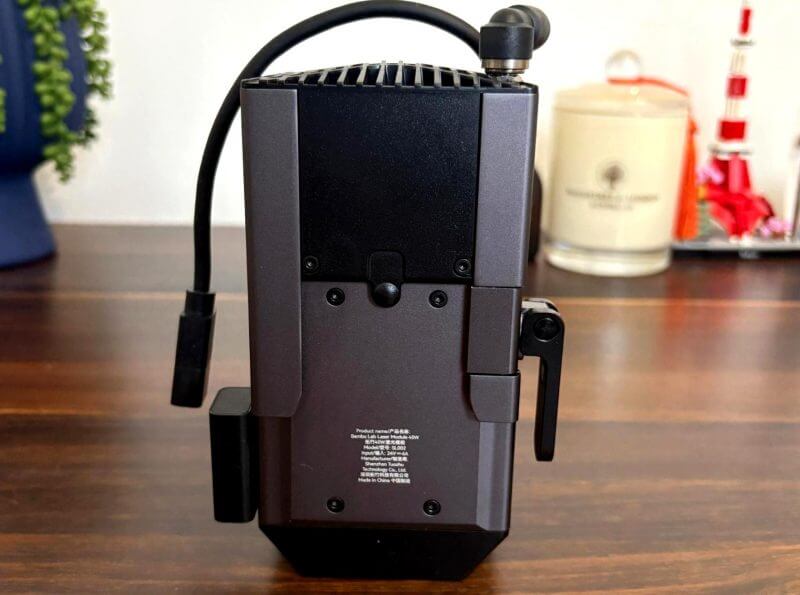
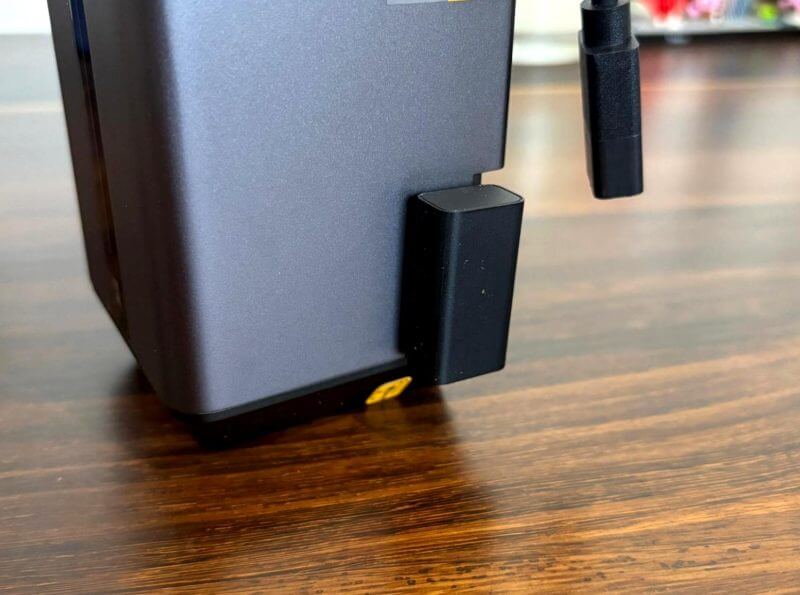
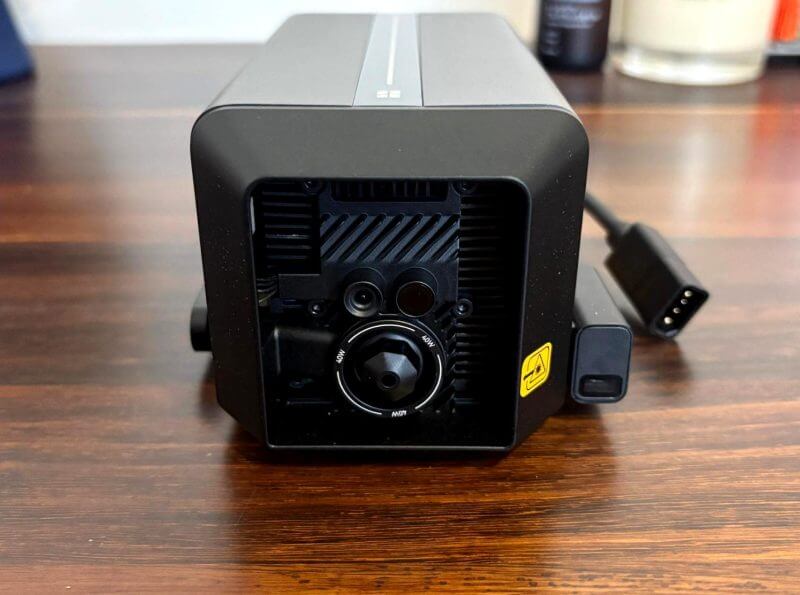
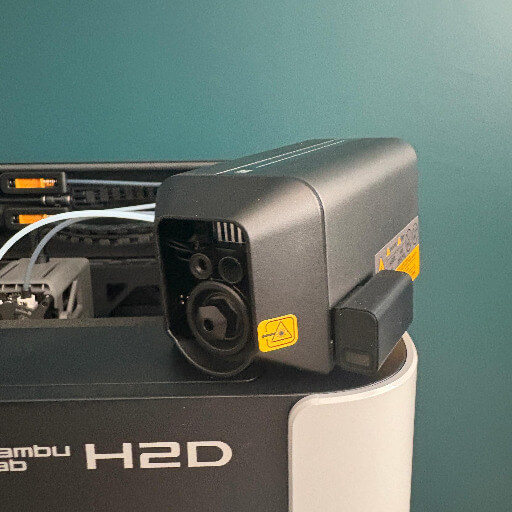
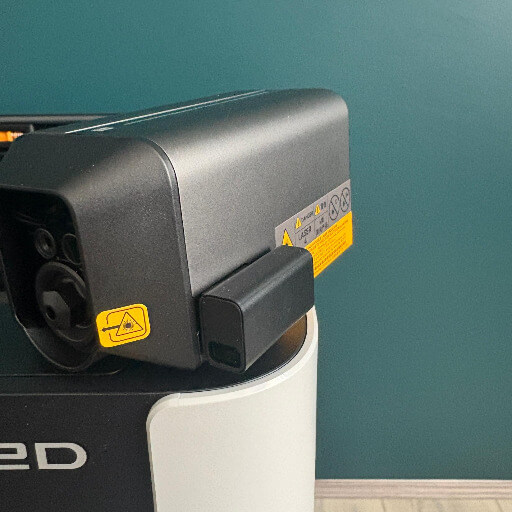
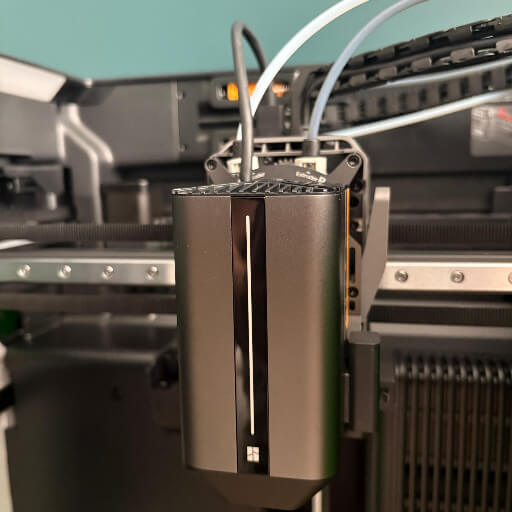
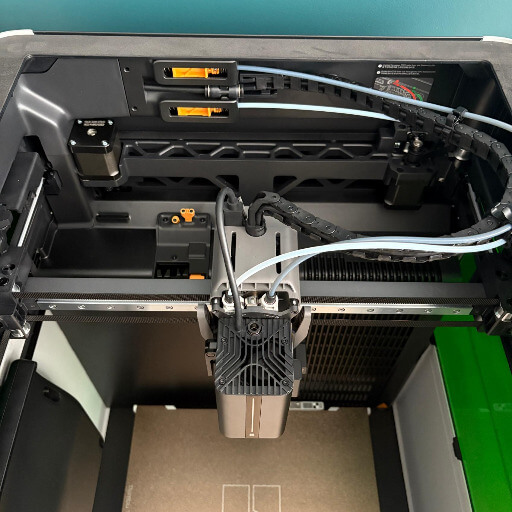
The Bambu Lab H2D and Laser Combo introduces laser functionality with a modular approach, offering both 10W and 40W diode laser modules depending on the user’s needs. These modules easily attach to the main printhead, allowing quick conversion between 3D printing and laser tasks without removing the base toolhead.
The 10W laser is well-suited to engraving and cutting thin materials like wood, cardboard, paper, and dark acrylic. It delivers clean results on most soft materials and is an excellent starting point for users looking to explore creative engraving and decorative marking.
Those needing more power will find the 40W laser module significantly expands cutting capabilities. This higher-powered diode laser can cut through several millimetres of wood, cork, leather, and some plastics in a single pass, ideal for more complex fabrication work.
Both laser modules benefit from integrated cooling and an air assist system, which helps maintain cut quality and prevents material scorching. The 40W unit, in particular, relies on this feature to clear debris during deep cuts and reduce fire risks.
Mounting either laser is simple, involving a tool-free lever system that locks the module securely to the printhead. This design choice makes transitioning between functions quick and encourages users to experiment with different tool combinations during projects.
The H2D detects the attached module automatically and adjusts system behaviour accordingly. When laser modules are connected, vent flaps open to channel smoke and fumes through the integrated exhaust duct, preparing the machine for safe operation.
Bambu Suite, the software responsible for laser and cutting jobs, offers a dedicated workspace for setting up engraving or cutting designs. It supports vector files, images, and hand-drawn elements, and even includes a QR code generator and font library for detailed custom work.
Cameras inside the H2D assist with previewing material placement and aligning designs before engraving begins. This feature is especially useful when working on small items or batches, ensuring consistent results across each cut.
The H2D can also read coded tags on compatible materials and plates, auto-adjusting settings to match the expected cut depth or power level. For custom materials, users can define and save personalised profiles for quick recall.
In real-world use, both lasers deliver strong performance. The 10W module is ideal for intricate, shallow work, while the 40W module handles thicker materials and even light metal marking, offering versatility for a wide range of laser-based projects.
Bambu Lab Smoke Purifier
The Bambu Lab Smoke Purifier is designed specifically to support the laser capabilities of the Bambu Lab H2D and Laser Combo, delivering effective air filtration during engraving and cutting tasks. It plays an essential role in maintaining a clean and safe working environment, particularly when working with materials known to emit smoke, dust, or volatile compounds.
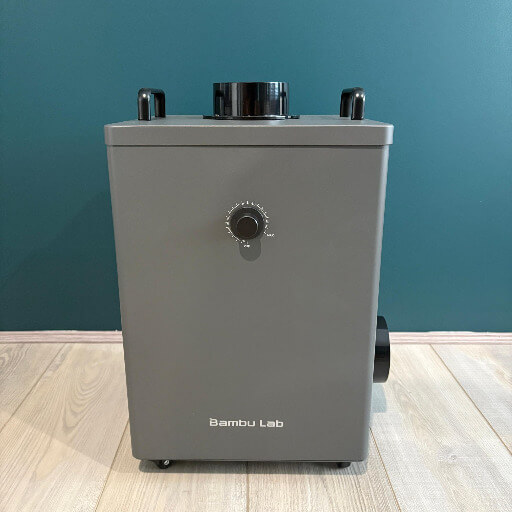
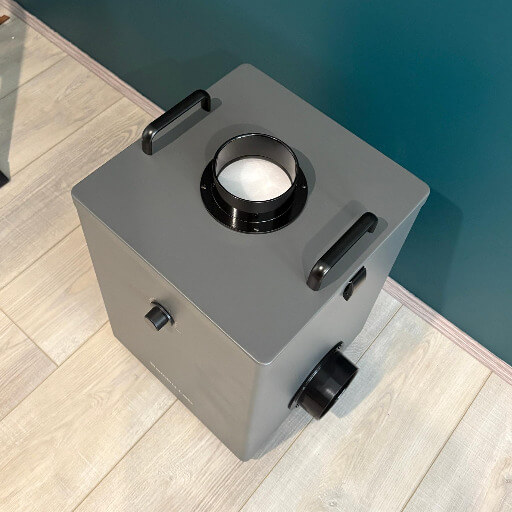

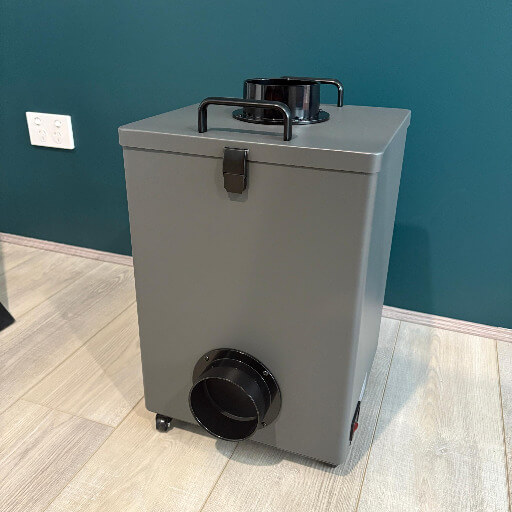
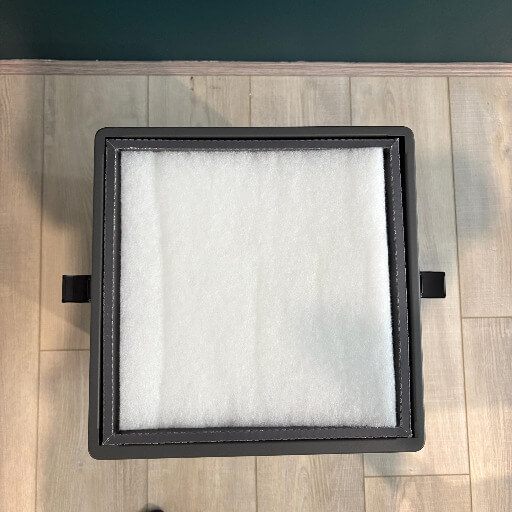
This compact yet powerful device uses a multi-stage filtration system that targets a wide range of airborne pollutants. It captures everything from large particles like dust and debris to ultra-fine particulates and harmful VOCs that can be released during laser processing of wood, acrylic, or synthetic materials.
The filtration setup begins with G4 and F8 pre-filters, which trap larger particles and extend the lifespan of the more sensitive filters. These are followed by a high-efficiency carbon filter that neutralises chemical vapours and odours, ensuring a more pleasant workspace.
At the heart of the system is a HEPA H13 filter capable of capturing 99% of airborne particles as small as 0.3 microns. This level of filtration helps reduce exposure to microscopic irritants and creates a healthier environment for long-duration laser work.
Despite its small footprint, the purifier is engineered to handle the demands of regular use. Its internal structure is built for high dust-holding capacity, which means fewer interruptions for filter changes and better long-term performance with minimal maintenance.
The purifier connects easily to the H2D’s ventilation outlet using the included 2-metre smoke pipe and clamp. Once connected, it works in tandem with the printer’s own ventilation system to extract and clean air from the chamber during laser operation.
Installation is simple and requires no special tools, with most of the filtration components already pre-installed in the unit. Spare primary filters are included in the box, allowing users to extend operation before needing to source replacements.
For anyone planning to use the laser functions regularly, the Bambu Lab Smoke Purifier is an essential companion. It not only improves air quality but also supports the machine’s versatility by making it suitable for use in offices, studios, or shared environments where ventilation may be limited.
Precision Cutter Functionality
The Bambu Lab H2D and Laser Combo includes a drag knife cutting module that enables precise 2D cuts through softer materials. This tool adds a new dimension to the machine’s capabilities, allowing for creative applications involving paper, vinyl, cardstock, and select fabrics.
The cutting tool attaches to the existing printhead using the same friction-lever system as the laser modules. This design makes it easy to swap between tools without needing to remove the 3D printing components or recalibrate the system.
Unlike rotary cutters or motorised blades, the drag knife relies on controlled movement to slice through materials. It uses vector files to define the shape and path of each cut, allowing intricate outlines and repeated patterns to be executed cleanly.
Users working in CAD or vector-based software can easily export designs into compatible formats for cutting. The integration with Bambu Suite simplifies this process by supporting SVG and other common file types, streamlining workflow from concept to cut.
The system includes dedicated plates for cutting tasks, offering both slatted and full-grid surfaces depending on the material being used. These help prevent snagging or slippage while keeping materials supported during drag cuts.
Camera-based alignment helps users place designs precisely on materials, which is especially useful when layering cuts with other functions like engraving or 3D printing. This functionality allows for mixed-media projects with tight tolerances and consistent results.
The cutting process is managed through Bambu Suite’s dedicated interface, where users can assign different operation types, such as blade cutting, pen plotting, or engraving. Each function can be configured with individual parameters like force, speed, and repeat passes.
When cutting thin films or adhesive vinyl, the drag knife is able to make clean separations without slicing through the backing layer. This precision is ideal for producing decals, labels, or stencil templates for use in other projects.
Cutting jobs require user confirmation at the machine before beginning, reinforcing safety and ensuring the correct tool is loaded. A built-in prompt system walks the user through setup, reducing the chance of error and boosting confidence for first-time users.
With the cutting module, the Bambu Lab H2D and Laser Combo proves itself as more than a 3D printer. It becomes a multi-material, multi-function creative platform that enables customisation, fabrication, and design prototyping far beyond additive manufacturing alone.
3D Printing Experience
The Bambu Lab H2D and Laser Combo offers a thoroughly refined 3D printing experience that caters to both professionals and enthusiasts. Its setup process is fast and intuitive, with the onboard touchscreen providing a step-by-step guide that walks users through the initial configuration.
Right from the start, the printer feels responsive and polished. The interface is snappy, with accessible menus, helpful animations, and light-hearted prompts that make daily use engaging without feeling gimmicky.
Dual extrusion is a standout feature that elevates the machine’s versatility well beyond single-nozzle systems. The printhead houses two hot ends, allowing for two filaments to be used in one job without tool changes or mid-print switching delays.
The printer’s nozzle-switching mechanism uses a clever actuator to physically shift the active nozzle while engaging a blocker on the idle one. This ensures that oozing or colour bleed between filaments is kept to a minimum, even on intricate multi-material parts.
AMS 2 Pro and AMS HT modules are deeply integrated into the machine’s workflow, simplifying filament management to the point where users rarely need to intervene manually. Each system tracks material usage, monitors humidity, and loads filament automatically as needed.
During dual-filament jobs, the software allows users to assign each filament to a specific nozzle, which reduces waste, improves detail clarity, and enables support structures to be printed with dissolvable or breakaway materials. It’s a huge benefit for functional and visually clean prints.
Filament loading and unloading are straightforward, thanks to clear onscreen instructions and easily accessible feeding points. Even flexible materials, which can be challenging for some machines, are manageable here with proper routing through the rear flexible filament port.
Flexible filaments like TPU require a bit more planning and setup time, especially if you’re using external filament dryers. However, once in place, the extruder handles these materials reliably, producing smooth, elastic parts with good adhesion and consistency.
The actively heated chamber contributes to excellent results with advanced materials like ABS, ASA, and carbon-fibre blends. It maintains a stable environment that helps minimise warping and delamination, even on taller prints or parts with long bridging spans.
Layer consistency is one of the H2D’s defining strengths. The DynaSense extruder, with its servo-driven torque and position control, ensures steady flow across even complex geometries, resulting in visibly uniform layering and tight dimensional accuracy.
High-speed printing is achievable without sacrificing detail, thanks to a maximum speed of 1,000 mm/s and rapid 20,000 mm/s² acceleration. These specs translate into real-world gains on larger models and batch runs, especially when paired with high-flow nozzles.
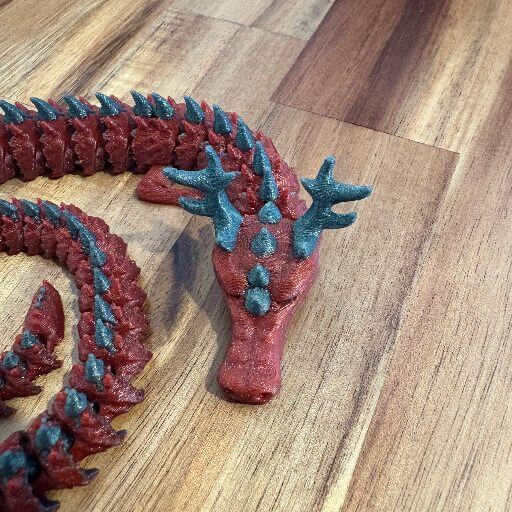
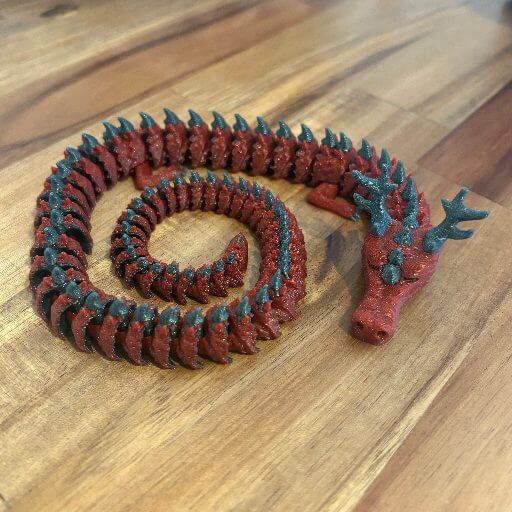
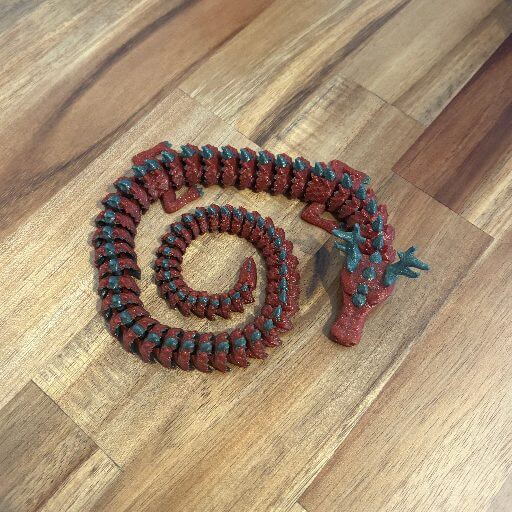
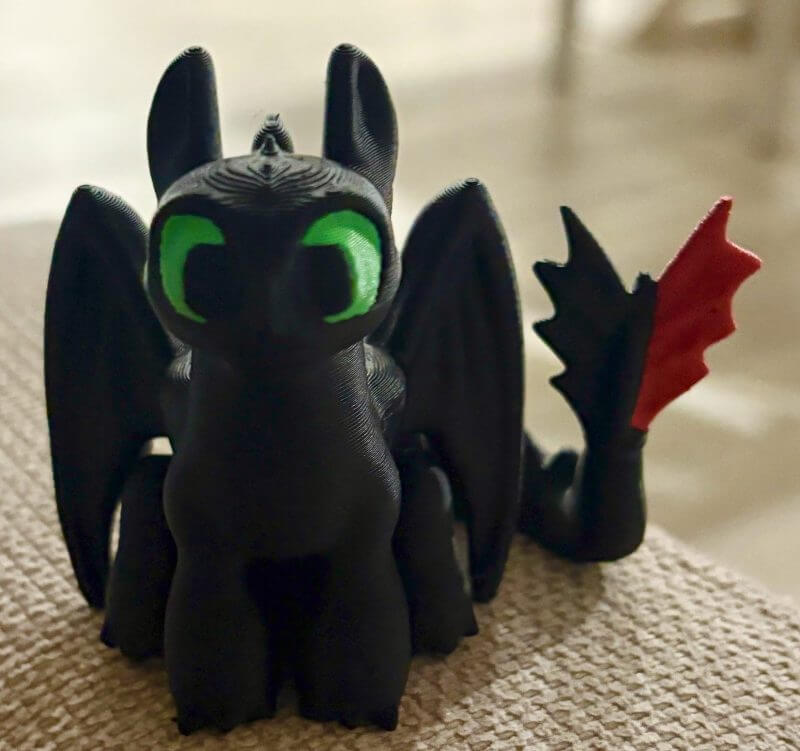
Hot end swaps are toolless, allowing users to easily switch nozzle sizes or replace components mid-project. This flexibility is especially valuable for users who regularly shift between high-detail work and fast prototyping.
Motion calibration using the optional encoder plate and internal camera system enhances print accuracy. This combination feeds real-time data back into the printer’s movement algorithms, helping to correct for slight deviations during fast or intricate movements.
Bambu Studio complements the hardware with an excellent slicer experience. Visual references for printer beds, toolheads, and filament assignments streamline the slicing process, while advanced settings are readily available for those who like to fine-tune their prints.
The software’s filament-saving mode intelligently distributes filaments between nozzles to minimise waste. It also detects opportunities to use existing loaded materials in the most efficient way, reducing the need for spool changes between jobs.
Convenience mode further simplifies this by automatically matching filament positions with appropriate nozzles based on availability and recent use. These modes reduce cognitive load, allowing you to focus on your design rather than logistical details.
Print removal is hassle-free, with magnetic plates or flexible beds making it easy to release parts without tools. Adhesion during printing is consistent across the bed’s surface, reducing first-layer issues and saving time on restarts.
Over long-term use, the Bambu Lab H2D and Laser Combo remains impressively consistent. Whether printing decorative pieces, functional prototypes, or multi-day production runs, the machine delivers clean results, minimal maintenance, and a user experience that feels genuinely refined.
Laser Experience
Using the laser modules on the Bambu Lab H2D and Laser Combo feels like a natural extension of the machine’s core capabilities. Whether you’re working with the 10W or 40W laser, the process is streamlined through automatic tool detection and intuitive software integration.
The 10W laser is well suited for lighter materials and engraving tasks, offering great precision on paper, cardboard, soft wood, and dark acrylic. It excels in projects that require intricate detail, such as decorative motifs, custom labels, or surface markings.
For those needing more cutting power, the 40W laser delivers deeper cuts through dense materials like hardwood, leather, and thicker acrylic. It also allows for light engraving on certain metals, which expands the machine’s creative and functional applications.
Swapping to laser mode is quick and does not require disassembling the core printhead. The tool attaches via a friction-based lever system, and once installed, the machine configures itself and opens the correct venting pathways automatically.
Bambu Suite handles laser jobs with a different workflow compared to the print-focused Bambu Studio. The process starts with design creation, allowing you to draw shapes, import vector files, or add elements like QR codes, borders, or text directly within the software.
The internal camera system assists with aligning your design on the material, displaying a real-time preview of the workspace. While there may be slight distortion from the fisheye lens, it’s still accurate enough for most practical needs.
Air assist plays a vital role when using the 40W module, keeping the cut path clean and reducing scorching. However, light materials can sometimes shift due to the force of the airflow, so extra attention may be needed when positioning them.
Ventilation is handled impressively, especially when paired with the Bambu Lab Smoke Purifier. The system keeps fumes under control and ensures a safe and comfortable workspace, even in closed environments like home offices or studios.
Operation safety is well-considered, with physical confirmation required at the machine before any laser job begins. A large emergency stop button is included with the Laser Combo edition, offering immediate shutdown in case of unexpected issues.
Across different projects, the laser modules perform reliably and produce high-quality results. Whether engraving text onto wood or cutting detailed shapes into leather, the Bambu Lab H2D and Laser Combo delivers clean, professional outcomes with minimal hassle.
Precision Cutter Experience
The precision cutting experience with the Bambu Lab H2D and Laser Combo is surprisingly capable for a drag-knife system. Designed for clean, detailed cuts through thinner materials, the cutter is ideal for vinyl decals, card stock, paper stencils, and light fabrics.
Attaching the cutting tool is a straightforward process, as it uses the same friction-based lever system as the laser module. There’s no need to remove or adjust the main printhead, allowing for fast transitions between 3D printing, laser, and cutting modes.
Bambu Suite’s dedicated tools for blade cutting make setup accessible, even for users unfamiliar with vector workflows. Files can be imported directly in SVG format, or drawn within the software using built-in shapes, text tools, or freehand lines.
During setup, the camera-assisted alignment system helps users place their design accurately on the material. This visual feedback is particularly helpful when cutting pre-printed materials or layering designs with other functions like engraving or printing.
The machine uses a slatted or grid-style support plate to keep flexible or lightweight materials in place. These surfaces reduce the chance of tearing or warping mid-cut, resulting in crisp edges and minimal material damage.
Cutting performance is smooth and consistent, with clean lines and reliable tracking even on intricate shapes or repeated patterns. Thicker or more fibrous materials may require multiple passes, which can be configured easily in the software.
The cutting blade operates based on vector paths, following curves and angles with high accuracy. Unlike laser cutting, the drag knife has no burn risk, making it better suited for jobs where thermal deformation would be a concern.
Operation requires confirmation at the printer, reinforcing the importance of safety. Once the job begins, the process is quiet and low-vibration, making it well suited for shared or quiet environments where noise may be a factor.
For layered projects—such as vinyl overlays on 3D printed parts—the cutter adds excellent flexibility to the creative process. Designs can be matched and aligned with printed surfaces using the H2D’s built-in visual tools.
Across a wide variety of materials and project types, the precision cutter module consistently delivers sharp, repeatable results. Its inclusion further extends the Bambu Lab H2D and Laser Combo’s role as a true all-in-one creative workstation.
Conclusion
The Bambu Lab H2D and H2D Laser Combo stands out as a highly capable, all-in-one creative solution that merges high-performance 3D printing with the added versatility of laser cutting, engraving, and precision blade work. Each function is integrated seamlessly, offering a streamlined experience that feels professional yet accessible.
Its dual-extrusion system, powerful motion control, and automated material handling provide a reliable and efficient 3D printing workflow. Whether you’re producing detailed models, functional parts, or multi-material pieces, the machine consistently delivers smooth, accurate results.
Laser and cutting features are more than just add-ons—they’re fully realised capabilities that expand what’s possible in a desktop environment. Combined with thoughtful safety systems, smart ventilation, and intuitive software, these features make the H2D and Laser Combo a practical choice for advanced makers and creative professionals.
For those seeking a multi-functional tool that doesn’t compromise on quality or ease of use, the Bambu Lab H2D and Laser Combo is an outstanding option. It simplifies complex workflows and invites experimentation, making it a valuable addition to any workspace.

